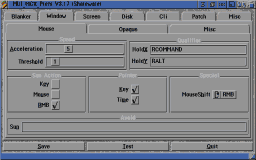
One of the few constants in the Amiga universe is the abundance of
software release as freeware or shareware. We may not have many
mainstream apps, but there is always a fresh supply of cool stuff
appearing on Aminet. Here are a few Workbench enhancement programs I
missed in the last segment of this series.

|
|
| Figure 1: MultiCX Prefs |
|---|
MultiCX (MCX253.lha, shareware,) by Martin Berndt, is a small multi purpose commodity with loads of features. Screenblanker, Mouse accelerator, mouseblanker, screencycling, SUN alike window activation, hotkey to flush memory, popCLI, quiet disk clicking, editing extension (cut and paste etc) for string gadgets, advanced reset handler, assignwedge, opaque window movement and sizing, a nifty window gauge to graphically show disk usage, Shapeshifter support in the form of shapefreezer, which freezes the Shapeshifter program when you return to the Workbench, to prevent screen corruption, and shapestick, which lets you use an Amiga joystick on the Mac side (Shapeshifter is the excellent Macintosh emulator, see Marc Hoffman's review in the Nov. 1995 issue of Amazing.) Of course MultiCX features a lot more than this. MultiCX is small, and very well programmed. MultiCX is configured by tooltypes, and thanks to a feature called notification, will automatically act on the new settings.
If you don't like using the tooltypes to configure MultiCX, Jürgen
Kempkes has written an external prefs program for MultiCX (mcxp317.lha,
shareware, requires MUI.) This program features a well organized MUI
interface with support for all of the MCX options. Note: it's
important to use the correct version of the prefs with each version of
MultiCX, usually the file comments will identify which version of
MultiCX is supported (mcxp317.lha supports version 2.53 of MultiCX.) See
Figure 1 for a screenshot of MultiCX prefs.
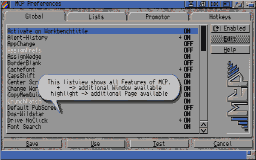
|
|
| Figure 2: Master Control Program Prefs |
|---|
MCP, the Master Control Program, (MCP110.lha, mailware, prefs require MUI) by Stefan Sommerfeld and Michael Knoke with addition work by Vincent Schöttke and Soeren Sonnenburg, is another multi function commodity with even more features than MultiCX, though it also uses more memory, and seems a bit less stable (at least on my system.) Included in the archive is a prefs program. MCP does most or all of what MultiCX does, and also features Alert history, to keep track of Guru alerts, Appchange to customize a programs app icon, Assign prefs, a power saver for monitors which support this feature, processor control and a patch to have 16 color pointers. See Figure 2 for the MCP prefs.
The Amiga's datatype system is flexible and very convenient. Programs written with the datatypes in mind can load a wide variety of data, without needing to support these formats directly. Datatypes are available in abundance, including image formats like PNG, TIFF, Targa JPEG and GIF, and other data formats like fonts, postscript, unix man pages, binary and more.
Datatypes do have several weak points, though. If your favorite
application doesn't support them, you're out of luck. At least you were
until Magic Picture Loader System (mpls_v1_4_demo.lha, shareware) came
along. This system patch, by Lejardinier Olivier,allows any application
to load data via the datatypes. The demo includes patches for
Brilliance and Dpaint. The full version will work with any application.
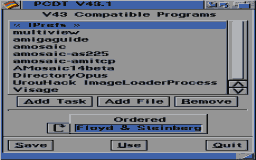
|
|
| Figure 3: Picture Datatype Prefs |
|---|
Another major fault is lack of 24 bit image support. Normally, all datatypes, even those for 24 bit formats like JPEG and Targa, only support up to 8 bit color, and will convert the 24 bit data when loaded. And oddly, IFF24 isn't supported at all. This is where a replacement picture datatype (PictDT43.748.lha, freeware) by Ralph Schmidt (with additional material by Frank Mariak and sub datatypes by Matthias Scheler) comes in. With this software installed, you can load, display, save, even copy to the clipboard 24 bit data. Note that this is a beta release, and is not fully done yet, though it seems pretty stable on my system. Because of it's beta status, it has a built in expiration date (four months from the release date, June 28, 1996, for this version.) after which it will no longer function. Make sure to get the Note that not everything will work with this new system. Cloanto's Personal Paint for instance, is apparently hard coded for 8 bit datatypes, and won't load 24 bit images such as JPEGs under the new picture datatype. Perhaps they will fix this (or already have done so) in a new release. Also note that this new picture datatype doesn't support ham8 displays, so viewing 24 bit images on AGA won't be really pleasing (It does support Cybergraphics, though.) See Figure 3 for the Picture datatypes prefs program.
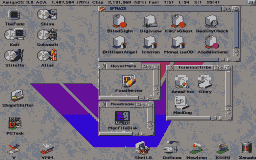
|
|
| Figure 4: Free at last: Borderless Icons |
|---|
One of the few things I don't like about Workbench 2.04+ is those funky borders drawn around all icons. It would be nice if you could turn them off. Well, you can, but there's a catch. Kamel Biskri's NoDraw and NoFill (NoDrawNoFill.lha, cardware) are 2 small patches which turn off the border drawing on icons. Unfortunately, the Amiga doesn't really like you to do this, so there are several shortcomings to be aware of. First, using these patches with a backdrop can result in very odd looking icons, as their colors seem to get scrambled. Actually, for once, my Rube Goldberg of a Workbench is actually an advantage. Because I use both NewIcons and lock all 16 of my workbench colors, my backdrop works just fine with these borderless icons (Though I do have to use the "redraw all" menu item once right after boot.) On the other hand, normal icons tend to look pretty crusty. I guess everything has a price. See Figure 4 for the borderless icon look.
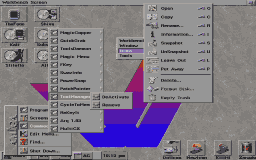
|
|
| Figure 5: Picture Menu at Upper Right |
|---|
If you've ever used a Macintosh, you may have noticed that the Mac can draw images in the menus. Pawel Pijanowski's PictureMenu (PictureMenu.lha, cardware) is a program that gives this capability to the Workbench. The included images (in MagicWB style) are actually colorfonts, and can be created or modified in a colorfont capable font editor. Note that Picturemenu does not coexist peacefully with other menu modifying programs like Rekeyit and ToolsDaemon. It DOES work nicely with MagicMenus, though. See figure 5 for a screenshot of PictureMenu (on the top right of picture, Startmenu, which I'll get to later, is on the bottom left.)
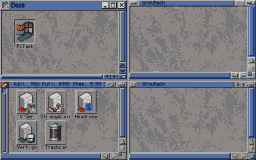
|
|
| Figure 6: Urouhack and Workbench 95 |
|---|
Apparently Sysihack (covered in the June, 1996 issue of Amazing) has started a trend. There have been a number of programs released which modify the Amiga's Window gadgets. Urouhack, (urouhack17.lha, giftware) by Tinic Urou, is perhaps the most ambitious, as it allows you to customize your window gadgets using any paint program which can save iff brushes. See Figure 6 for varous Urouhack (as well Workbench 95, see below) window dressings.
Another trend has been the attempt to make the Amiga operate more like Windows 95. I'm tempted to misquote the president, and say "We could do that -it would be wrong- but we could do that."
While personally against the idea, here are a couple of programs to "start you up." (Excuse me, I'm feeling a strange compulsion to smash all my Rolling Stones records now, I'll be right back...)
Workbench95 (Workbench95.lha, freeware) is a Sysihack style program
to add Windows95 style window icons to the Amiga's windows. The author,
[email protected] (he didn't mention his name) went out of his
way to declare this program a hack, and warn people not to rely on it,
so it may be buggy.

|
|
| Figure 5: Look to the bottom for Start Menu |
|---|
John Corigliano's StartMenu (StartMenu2.lha, freeware) mimics the Windows95 Start button and taskbar, this is the best taskbar program I've seen, and has lots of features, such as date/clock display, launching of programs, a nice commodities exchange function and the ability to customize the menu. See Figure 5 for Startmenu in action.
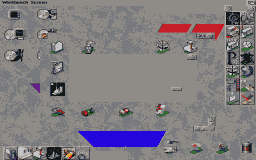
|
|
| Figure 7: Scary Workbench feature |
|---|
Finally, for those who've seen everything, Figure 7 shows one of the stranger 'features' writing this series of articles has given my Amiga. Infrequently, booting up will result in my Workbench looking like this. No icon text and no window borders, gadgets or text. Everything runs just fine, but looks peculiar. Very odd. I don't know which (or which combination) programs I'm running is doing this, but I take this as a clear indication that I'm flying too near the sun!
Well, this old Workbench is looking pretty spiffy. But sometimes, adding
a new coat of paint or new fixture just isn't enough. Next time, I'll
present a few ideas I'd like to see in the PowerAmiga version of
Workbench. See ya then.
 |
||||||
|